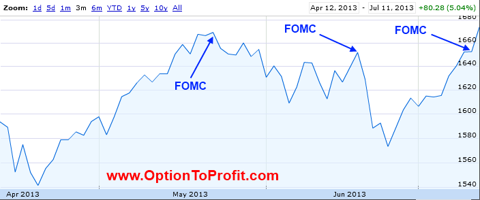 You’re only as good as your earnings. Having stopped making an honest living a little on the early side, I still need to make money, or otherwise my wife would insist that I do something other than watch a moving stock ticker all day.
You’re only as good as your earnings. Having stopped making an honest living a little on the early side, I still need to make money, or otherwise my wife would insist that I do something other than watch a moving stock ticker all day.
Since there’s far too much competition on the highway exit near our home and my penmanship has deteriorated due to excessive keyboard use, I’ve come to realize that stock derived earnings, predominantly from the sale of options and accrual of dividends, are the only thing keeping me from joining those less fortunate.
I’m under no delusions. I am only as good as my earnings, just as Bob Greifeld, CEO of NASDAQ (NDAQ) should be under no delusions, as he is only as good as his response to the most recent NASDAQ failing.
On that count, I may have the advantage, although he may have better hygiene and a wardrobe that includes a clean hoodie.
There was a time that we thought of stocks in very much the same earnings centric way. If earnings were good the stock was good. There was a time that we didn’t dwell quite as much on the macro-economic data and we certainly didn’t spend time thinking about Europe or China.
However, after this most recent earnings season, which will come to an end a few days before the next season is kicked off on October 8, 2013, maybe it’s a good thing that it’s only during the otherwise slow summer months when other news is sparse, that we focus on earnings.
If you’ve been paying attention, this hasn’t been a particularly encouraging month, especially as far as retail sales go, which are about as good a reflection of discretionary spending as you can find. Beyond that, listening to guidance can make shivers run down one’s spine as less than rosy earnings pictures are being painted for the future. The very future that our markets are supposed to be discounting.
As it is the S&P 500 is now about 0.3% below the earlier all time high that was hit on May 21, 2013. That in turn gave way to a rapid 5.7% fall and equally rapid 8.6% recovery to new highs. By all historical measures that post-May 21st drop was small as compared to the gains since November 2012 and we are right back to that level.
Perhaps once summer is over and our elected officials return to Washington, DC, not only would they have an opportunity to see me at a highway exit, but they may also get back to doing the things that create the dysfunction that makes earnings less salient.
As usual, the week’s potential stock selections are classified as being in Traditional, Double Dip Dividend, Momentum and “PEE” selections this week (see details).
Most of the positions considered this week are themselves lower than they were at the low point following the May 21st peak and have underperformed the S&P 500 since that time. For the moment, as I contribute to cling to the idea that there will be some additional market weakness, my comfort level is increased by focusing on positions that don’t have as much to fall.
I’ve been anxious to buy either Cisco (CSCO) or Oracle (ORCL) ever since Cisco’s disappointing earnings report. During more vibrant markets a drop in the share price of an otherwise good company would stand out as a buying opportunity. However, recently there has been more competition among those companies suffering precipitous earnings related price drops. While striving to keep my cash reserves at sufficient levels to allow me to go on a wild spending spree, I’ve resisted opportunities in CIsco and Oracle. Both, however, are getting more and more appealing as their prices sink further.
Oracle will report its earnings right before the end of the September 2013 option cycle and I have a very hard time believing that it could be three disappointments in a row, especially after some high profile remarks by CEO Larry Ellison regarding leadership at Apple (AAPL) that could come back to haunt him, even if only in terms of comparative share performance.
A technology company that always intrigues me, if at the price point relative to its option contract strikes, is Cypress Semiconductor (CY). It’s products and technology are quietly everywhere. However, its CEO, T.J. Rodgers has become precisely the opposite, as he is increasingly appearing in the media and offering political and policy opinions that make you wonder whether he is getting detached from the business, as perhaps may be said of Ellison. In Cypress Semiconductor’s case I think the business is small and focused enough that it can withstand some diversions. It is one of the few positions that has outperformed the S&P 500 since May 21st.
Among companies reporting earnings this week is salesforce.com (CRM), which also has Larry Ellison connections. the most recent of which is a great example of how business and strategic needs may trump personal feelings. For those who would innocently suffer collateral damage otherwise, that is the way it should be, as two companies seek to have the sum of their parts create additional value. While I do own shares of salesforce.com, I would be inclined to consider the sale of puts as a means to add additional shares and achieve an earnings stream of 1% for the week while awaiting the market’s reaction to earnings. My only hesitancy is that the strike at which that return can be achieved as more close to the strike of the implied move downward than I would ordinarily like.
Having recently lost shares of Eli Lilly (LLY) to early assignment in order to capture its dividend, I’ve wanted to re-purchase shares. Along with Bristol Myers Squibb (BMY) that I have been wanting to add for a while, they both offer attractive option premiums and are both 5% below their May 21st prices, which I believe limits their short term risk, during a period that I prefer to be somewhat defensive. Additionally, Bristol Myers offers extended weekly options that can be used as part of a broader strategy to attempt and stagger option expiration dates and perhaps infusions of cash back into portfolios for new purchases.
Sinclair Broadcasting Group (SBGI) is a local television broadcasting powerhouse that just purchased the important Washington, DC ABC affiliate. But it is far more than a local presence, as it has quietly become the nation’s largest operator of television stations, barely 4 years after fears of bankruptcy. Of course its recent buying spree may put pressures on the bottom line, but for now it is coming off a nearly 8% earnings related price decline and goes ex-dividend this week. Both of those work for me.
JP Morgan (JPM) which is increasingly becoming the poster child for everything wrong with big banks, at least from the point of view of regulators and the Department of Justice, finally showed a little bit of price stability by mid-week. Although I don’t know how any initiatives directed toward JP Morgan will work out, I’m reasonably sure that talk of looking at Jamie Dimon as a potential Treasury Secretary won’t be rekindled anytime soon. At current price levels, however, I think shares warrant another look.
While I’m not a terribly big fan of controversy, I think it may be time to publicly proclaim support for Cliffs Natural Resources (CLF). Having suffered through ownership beginning prior to the dividend cut, it has been an uncomfortable experience, ameliorated a bit by occasional purchase of additional shares and sacrificing them for their option premiums. Beginning with a report approximately 6 weeks ago that China had purchased a massive amount of nickel in the London commodity market, Cliffs has been slowly showing strength that may suggest demand for iron ore is increasing. Held hostage to our perceptions of the health of the Chinese economy, which can vary wildly from day to day, Cliffs’ share price can be equally volatile, but I believe will be rewarding for the strong of stomach.
Finally, Abercrombie and Fitch (ANF) was widely criticized as no longer being “cool.” That suits me just fine, figuratively, but not literally, as I resist wearing anyone’s logo with compensation. However, after joining other teen retailers in receiving earnings related punishment, I sold puts on its shares and happily saw them expire. Long a favorite stock of mine on which to generate option premium income, I think it’s at a price level that may offer some stability even with a demographic customer base that may not offer the same stability. This has been a great company to practice serial covered call writing, as long as you have a parallel strategy during the week of earnings release. In this case, that leaves three months of evaluating opportunities and perhaps even receiving a dividend before the next quarterly challenge.
Traditional Stocks: Bristol Myers Squibb, Cisco, Cypress Semiconductor, Eli Lilly, JP Morgan, Oracle
Momentum Stocks: Cliffs Natural Resources
Double Dip Dividend: Abercrombie and Fitch (ex-div 8/29), Sinclair Broadcasting (ex-div 8/28)
Premiums Enhanced by Earnings: salesforce.com (8/29 PM)
Remember, these are just guidelines for the coming week. The above selections may be become actionable, most often coupling a share purchase with call option sales or the sale of covered put contracts, in adjustment to and consideration of market movements. The over-riding objective is to create a healthy income stream for the week with reduction of trading risk.
Views: 12

 I believe, although I could be mistaken, that an original version of the Bible suggested that “an octogenarian shall lead them.”
I believe, although I could be mistaken, that an original version of the Bible suggested that “an octogenarian shall lead them.”

 To summarize: The New York Post rumors, “The Dark SIde” and the FOMC.
To summarize: The New York Post rumors, “The Dark SIde” and the FOMC.
 This week may have marked the last time Ben Bernanke sits in front of far less accomplished inquisitors in fulfilling his part of the obligation to provide congressional testimony in accordance with law.
This week may have marked the last time Ben Bernanke sits in front of far less accomplished inquisitors in fulfilling his part of the obligation to provide congressional testimony in accordance with law.


 The hard part about looking for new positions this week is that memories are still fresh of barely a week ago when we got a glimpse of where prices could be.
The hard part about looking for new positions this week is that memories are still fresh of barely a week ago when we got a glimpse of where prices could be.
You must be logged in to post a comment.